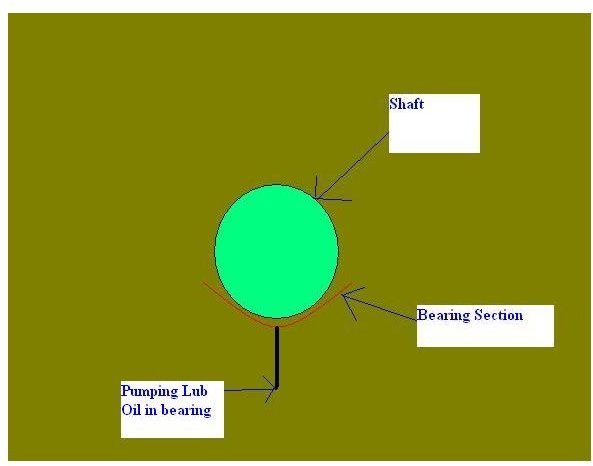How to Lubricate the Journal Bearings in a Marine Diesel Engine
Introduction
In the previous article we learnt about a few basic concepts of lubrication in marine diesel engines. We also saw that various types of lubrication is necessary depending on the type of relative motion between the components under consideration. In this article we will study the lubrication techniques used in parts where rotary motion exists between the moving surfaces.
Hydrodynamic Lubrication
The lubrication concept related to situations such as those found in a journal bearing is known as hydrodynamic lubrication wherein a wedge of the lubricating oil is formed and helps to separate the two surfaces. The journal bearing or other types of bearings experience this phenomenon and this can be understood more clearly with the diagram shown below.
The diagram shows a green coloured shaft rotating within a bearing a section of which is shown in red colour. When the shaft is at rest there is hardly any oil between the area of contact between the shaft and the bearing especially if the shaft under consideration is quite heavy as that would simply squeeze out due to the weight of the shaft. When the shaft starts to move slowly there exists imperfect lubrication between the surfaces and there are chances of we and tear. It is the property of oiliness or stickiness which would be helpful for lubrication at this stage. Finally when the shaft is at rotation at a high speed the normal hydrodynamic lubrication takes place and separates the two surfaces
In cases where the speed of the shaft is not large enough for the thick film lubrication to take place forced lubrication is used by pumping oil using some kind of a pump from the bottom end of the bearing as has been shown using a thick black coloured line which depicts the lubricating oil line1. Sometimes a splash system of some kind can also be used which simply splashes oil over the requisite surfaces just as you would manually pour oil intermittently over two moving surfaces to keep them lubricated.
Apart from the speed of relative motion between the shaft and the bearing other factors which affect the formation of the lubrication film between the two surfaces are the viscosity of the lubricant and the shape of the surfaces in contact as well.
In the next article we will study about the lubrication process when the motion involved is not purely rotational but of oscillating nature.
-———————————————————————————————————————————————————————–
1. Note: in normal marine engineering practice standard codes are used to depict lines of different types such as yellow colour for lubricating oil and so forth, hence this diagram is simply descriptive in nature not following exact guidelines for sake of simplicity.
